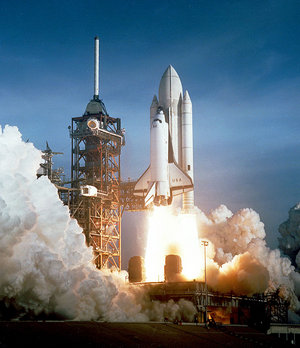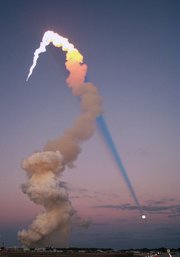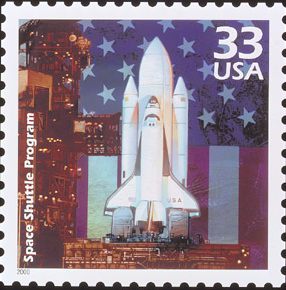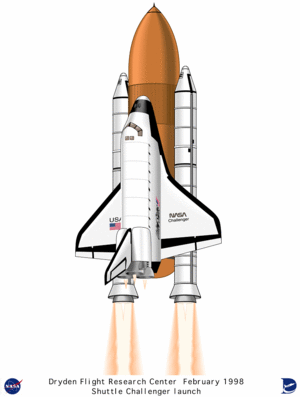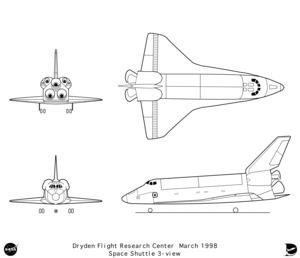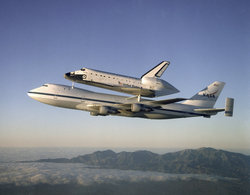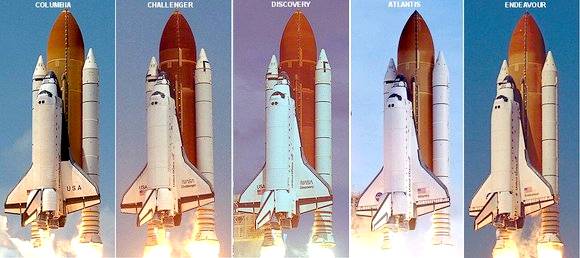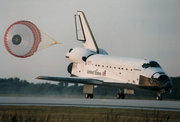|
|
|||||||||||||||||||||||||||||||||||||||||||||||||||||||||||||||||||||||||||||||||||||||||||
|
HOME | BIOLOGY | FILMS | GEOGRAPHY | HISTORY | INDEX | INVESTORS | MUSIC | SOLAR BOATS | SPORT |
|||||||||||||||||||||||||||||||||||||||||||||||||||||||||||||||||||||||||||||||||||||||||||
|
NASA's Space Shuttle, officially called Space Transportation System (STS), is the United States government's sole manned launch vehicle currently in service. The Space Shuttle orbiter was manufactured by North American Rockwell, now part of the Boeing Company. Martin Marietta (now part of Lockheed Martin) designed the external fuel tank and Morton Thiokol (now the Thiokol corporation) designed the solid rocket boosters.
The Shuttle is the first spacecraft designed for partial reusability. It carries large payloads to various orbits, provides crew rotation for the International Space Station (ISS), and performs servicing missions. While the vehicle was designed with the capacity to recover satellites and other payloads from orbit and return them to Earth, this capacity has not been used often; it is, however, an important use of the Space Shuttle in the context of the ISS program, as only very small amounts of experimental material, hardware needing to be repaired, and trash can be returned by Soyuz.
Space Shuttle Columbia ignition 1981. Tanks first 2 missions painted white. Subsequently tanks unpainted exposing rust colour insulation saving 1,000 lb (450 kg)
Each Shuttle was designed for a projected lifespan of 100 launches or 10-years operational life. The program started in the late 1960s and has dominated NASA's manned operations since the mid-1970s. According to the Vision for Space Exploration, use of the Space Shuttle will be focused on completing assembly of the ISS in 2010, after which it will be replaced by the yet-to-be-developed Crew Exploration Vehicle (CEV). However, following the STS-114 return-to-flight mission in August 2005, the Shuttle program is currently grounded pending repairs and the solution of outstanding safety issues.
Further aggravating the shuttle's return to space, also in August 2005 the Space Shuttle external tank construction site, Michoud Assembly Facility located in New Orleans, Louisiana was damaged by Hurricane Katrina, with all work shifts cancelled up to September 26, 2005. This could potentially set back further Shuttle flights by at least two months and possibly more.
History
The Shuttle decision
NASA had conducted a series of paper projects throughout the 1960s on the topic of reusable spacecraft to replace their expedient "one-off" systems like Mercury, Gemini, and Apollo. Meanwhile, the U.S. Air Force had a continuing interest in smaller systems with more rapid turn-around times, and were involved in their own space plane project, the X-20 Dyna-Soar. In several instances groups from both worked together to investigate the state of the art.
With the major Apollo development effort winding down in the second half of the 1960s, NASA started looking to the future of the space program. They envisioned an ambitious program consisting of a large space station being launched on huge boosters, served by a reusable logistics "space shuttle," both providing services for a permanently manned Lunar colony and eventual manned missions to Mars.
However, in reality, NASA found itself with a rapidly plunging budget. Rather than trying to adapt their long-term future to their dire financial situation, they attempted to save as many of the individual projects as possible. The mission to Mars was rapidly dismissed, but the Space Station and Shuttle conserved. Eventually only one of them could be saved, so it stood to reason that a low-cost Shuttle system would be the better option, because without it a large station would never be affordable.
A number of designs were proposed, but many of them were complex and varied widely in their systems. An attempt to re-simplify was made in the form of the "DC-3" by one of the few people left in NASA with the political importance to accomplish it, Maxime Faget, who had designed the Mercury capsule, among other vehicles. The DC-3 was a small craft with a 20,000-pound (9 tonne) (or less) payload, a four-man capacity, and limited maneuverability. At a minimum, the DC-3 provided a baseline "workable" (but not significantly advanced) system by which other systems could be compared for price/performance compromises.
Shuttle launch at sunset
The defining moment for NASA was when they, in desperation to see their only remaining project saved, went to the Air Force for its blessing. NASA asked that the USAF place all of their future launches on the Shuttle instead of their current expendable launchers (like the Titan II), in return for which they would no longer have to continue spending money upgrading those designs the Shuttle would provide more than enough capability.
The Air Force reluctantly agreed, but only after demanding a large increase in capability to allow for launching their projected spy satellites (mirrors are heavy). These were quite large, weighing an estimated 40,000 pounds (18 tonnes), and needed to be put into polar orbits, which require higher energies than lower inclination orbits; and since the Air Force also wanted to be able to abort after a single orbit (as did NASA), and in addition land at the launch site (unlike NASA), the spacecraft would also require the ability to maneuver significantly to either side of its orbital track to adjust for launch-point rotational drift while in polar orbit for example, in a 90-minute orbit, Vandenberg AFB would drift over 1,000 miles (1,600 km), whereas in more equatorially aligned orbits, the required cross-range would be less than 250 mi/400 km. This large "cross-range" capability for polar orbits meant the craft had to have a greater lift-to-drag ratio than originally planned, requiring the addition of bigger, heavier wings.
The result was that the simple "DC-3" was clearly irrelevant because it had neither the cargo capacity nor the cross-range the Air Force demanded. In fact, all existing designs were far too small, as a 40,000-pound (18 tonnes) delivery to polar orbit equates to a 65,000-pound (29 tonne) delivery to an eastwardly launched orbit with typical 28-degree inclination. Additionally, any design using simple straight or foldout wings was not going to meet the cross-range requirements, so any future design would require a more complex, heavier delta wing. Of further concern, any increase in the weight of the upper portion of a launch vehicle, which had just occurred, required an even bigger increase in the capability of the lower stage used to launch it. Suddenly, the two-stage system had grown in size to something larger than the Saturn V, and the complexity and costs to develop it soared.
While all of this was going on, others were suggesting a completely different approach to the future. They stated that NASA would fare better using the existing Saturn to launch their space station, supplied and manned using modified Gemini capsules on top of the Air Force's newer Titan II-M. The cost of development for this looked to be considerably less than the Shuttle alone, and would have a large space station in orbit earlier.
In reply, advocates of the Shuttle answered that given enough launches, a reusable system would more than pay for the cost of development when compared with the launch costs of disposable rockets. Another factor in the cost-benefit analysis was inflation, and in the 1970s this was high enough that the payback from the development had to happen very quickly to see a positive return. Hence, a high launch rate was needed to make the system economically feasible.
But it was infeasible that a space station or Air Force payloads could demand such rates (roughly one or two a week), so they insisted and suggested that all future U.S. launches would take place on the Shuttle, once built. In order to do this, the cost of launching the Shuttle would have to be lower than any other system, with the exception of very small rockets, ignored for practical reasons, and very large boosters, which were rare and excessively expensive in any case.
With a baseline project now gelling, NASA started to work through the process of obtaining stable funding for the five years the project would take to develop. Once again, they found themselves in an increasingly deplorable situation.
With the budgets being pressed by inflation in the U.S. and the Vietnam War abroad, Congress and the Administration were generally uninterested in long-term projects such as space exploration. Some members were therefore looking to further cut NASA's budget; but with a single long-term project confirmed, they could do little in terms of cutting whole projects the Shuttle was the single one left, and its cancellation would mean that there would be no U.S. manned space program by 1980.
Instead, they looked to reduce the year-to-year costs of development to a stable figure. That is, they wished to see the development budgets spread out over several more years. This was somewhat impractical and in conflict with the planned funding and development. The result was another intense series of redesigns in which the reusable booster was eventually abandoned due to its high price. Unsurprisingly, some designs for reusable boosters amounted to vehicles the size of the then-new Boeing 747, which would have to fly faster than the record-holding and considerably smaller X-15 rocket plane. Instead, a series of simpler rockets would launch the system and then drop away for recovery. Another change was that the fuel for the Shuttle itself was placed in an external tank instead of internal tanks as in the previous designs. This allowed a larger payload bay in an otherwise much smaller craft, although it also meant throwing away the tankage after each launch.
The last remaining debate was over the nature of the boosters. NASA had been looking at no less than four solutions to this problem: one a development of the existing Saturn lower stage, another using simple pressure-fed liquid-fuel engines of a new design, and finally either a large, single solid rocket, or two (or more) smaller ones. The decision was eventually made on the smaller solids due to their lower development costs (a decision that had been echoed throughout the whole Shuttle program). While the liquid-fueled systems provided better performance and enhanced safety, delivery capability to orbit is much more a function of the upper-stage performance and weight than the lower; the money was hence spent elsewhere.
Postage stamp depicting shuttle program
Development
The Shuttle program was launched on January 5, 1972, when President Richard M. Nixon announced that NASA would proceed with the development of a reusable, low-cost Space Shuttle system.
The project was already to take longer than originally anticipated due to the year-to-year funding caps. Nevertheless, work started quickly and several test articles were available within a few years.
Most notable among these was the first complete Orbiter, originally to be known as Constitution. However, a massive write-in campaign from fans of the Star Trek television series convinced the White House to change the name to Enterprise. Amid great fanfare, the Enterprise was rolled out on September 17, 1976, and later conducted a successful series of glide-approach and landing tests that were the first real validation of the design.
The first fully functional Shuttle Orbiter, built in Palmdale, California, was the Columbia, which was delivered to Kennedy Space Center on March 25, 1979, and was first launched on April 12, 1981 - the twentieth anniversary of Yuri Gagarin's space flight -, with a crew of two. Challenger was delivered to KSC in July 1982, Discovery was delivered in November 1983, and Atlantis was delivered in April 1985. The Shuttle was meant to visit Space Station Freedom, announced in 1984, an ambitious and much-delayed project later downsized and merged into the International Space Station program. Challenger was destroyed in an explosion during launch on January 28, 1986, with the loss of all seven astronauts on board. Endeavour was built to replace it (using spare parts originally intended for the other Orbiters) and delivered in May 1991. Columbia was lost, with all seven crew members, during reentry on February 1, 2003, and has not been replaced.
Reusable Orbiter (center copper colored object) Boosters to right & left of External Tank
Description
The Shuttle has a large 60 by 15 ft (18 by 4.6 m) payload bay, filling most of the fuselage. The payload bay doors have heat radiators mounted on their inner surfaces, and so are kept open for thermal control while the Shuttle is in orbit. Thermal control is also maintained by adjusting the orientation of the Shuttle relative to Earth and Sun. Inside the payload bay is the Remote Manipulator System, also known as the Canadarm, a robot arm used to retrieve and deploy payloads. Until the loss of Columbia, the Canadarm had been used only on those missions where it was needed. Since the arm is a crucial part of the Thermal Protection Inspection procedures now required for Shuttle flights, it will probably be included on all future flights.
The Space Shuttle system has undergone numerous improvements over the years. The Orbiter has changed its thermal protection system several times in order to save weight and ease workload. The original silica-based ceramic tiles need to be inspected for damage after every flight, and they also soak up water and thus need to be protected from the rain. The latter problem was initially fixed by spraying the tiles with Scotchgard, but a custom solution was adopted. Later, many of the tiles on the cooler portions of the Shuttle were replaced by large blankets of insulating feltlike material, which means huge areas (notably the cargo bay area) no longer have to be inspected as often.
Internally the Shuttle remains largely similar to the original design, with the exception that the avionics continue to be improved. The original systems were "hardened" IBM 360 computers connected to analog displays in the cockpit similar to contemporary airliners like the DC-10. Today the cockpits have been replaced with "all glass" systems and the computers themselves are many times faster. The computers use the HAL/S programming language. In the Apollo-Soyuz Test Project tradition, programmable calculators are carried as well (originally the HP-41C). In addition to the "glass cockpit," several improvements have been made for safety reasons after the Challenger explosion, including a crew escape system for use in a narrow range of situations that require the Orbiter to "ditch." With the coming of the Space Station, the Orbiter's internal airlocks are being replaced with external docking systems to allow for a greater amount of cargo to be stored on the Shuttle's mid-deck during Station re-supply missions.
Shuttle Orbiter diagram showing main engines
The Space Shuttle Main Engines have had several improvements to enhance reliability and power. This is why during launch you may hear curious phrases such as "Go to throttle-up at 106%." This does not mean the engines are being run over limit. The 100% figure is the power level for the original main engines. The actual engine contract requirement was for 109%. The original flight engines could handle 102%. The 109% number was finally reached in flight hardware with the Block II engines in 2001.
For STS-1 and STS-2 the external tank was painted white to protect the insulation that covers much of the tank, but improvements and testing showed that it was not required. This saved considerable weight, and thereby increases the payload the Orbiter can carry into orbit. Additional weight was saved by removing some of the internal "stringers" in the hydrogen tank that proved unnecessary. The resulting "light-weight external tank" has been used on the vast majority of Shuttle missions. STS-91 saw the first flight of the "super light-weight external tank". This version of the tank is made of the 2195 Aluminum-Lithium alloy. It weighs 7,500 lb (3.4 t) less than the last run of lightweight tanks. As the Shuttle cannot fly unmanned, each of these improvements has been "tested" on operational flights.
And, of course, the SRBs (Solid Rocket Boosters) have undergone improvements as well. Notable is the adding of a third O-ring seal to the joints between the segments, which occurred after the Challenger accident.
A number of other SRB improvements were planned in order to improve performance and safety, but never came to be. These culminated in the considerably simpler, lower cost, probably safer and better performing Advanced Solid Rocket Booster which was to have entered production in the early to mid-1990s to support the Space Station, but was later cancelled to save money after the expenditure of $2.2 billion. The loss of the ASRB program forced the development of the SLWT, which provides some of the increased payload capability, while not providing any of the safety improvements. In addition the Air Force developed their own much lighter single-piece design using a filament-wound system, but this too was cancelled.
A cargo-only, unmanned variant of the Shuttle has been variously proposed and rejected since the 1980s. It is called the Shuttle-C and would trade reusability for cargo capability with large potential savings from reusing technology developed for the Space Shuttle.
Components
The Space Shuttle consists of three main components: the reusable Orbiter itself, a large, brown, expendable external fuel tank, and a pair of white, reusable solid-fuel booster rockets. The fuel tank and booster rockets are jettisoned during ascent, so only the Orbiter goes into orbit.
Initial plans for the so-called Space Transportation System included space tugs and extra fuel tanks for the orbital-maneuvering-system engines, among many other concepts. None of this hardware has actually ever been built.
Shuttle Atlantis on Boeing 747 Shuttle Carrier Aircraft (SCA) 1998
Technical data
Normal Ascent
Initially the main engines are lit and checked out; if successful, the SRBs are lit and the vehicle is then committed to takeoff.
At takeoff the vast majority (~90%) of the thrust is provided by the SRBs. Shortly after clearing the tower the Shuttle rotates so that the vehicle is below the main tank and SRBs. The vehicle climbs in a progressively flattening arc, accelerating as the weight of the SRBs and main tank reduces. To reach orbit, the vehicle needs to reach high altitude, but more importantly it needs to achieve mach 25 sideways, and so must spend as much time as possible accelerating horizontally.
Around a point called "max-q", where the aerodynamic forces are at their maximum, the main engines are temporarily throttled back to avoid overspeeding and hence overstressing the Shuttle (particularly vulnerable parts such as the wings).
126 seconds after launch, the SRBs thrust reduces and then explosive bolts release them from the vehicle and they fall back to the ocean to be reused. The Shuttle then continues to accelerate most of the way to orbit on the Space Shuttle Main Engines. The vehicle at that point has a thrust to weight ratio of less than one it is relying on the initial velocity given to it by the SRBs; the main engines have too little thrust to accelerate the weight of the fuel at that point in the flight.
As the vehicle continues to climb, it takes on a nose-up angle to the horizon it uses the main engines to gain and then maintain altitude whilst it continues to accelerate horizontally towards orbit.
As the weight of the propellant reduces, the vehicle accelerates faster and faster until it has sufficient thrust to exceed the force of gravity. Finally, in the last tens of seconds towards the end of the main engine burn, the weight of the vehicle is low enough that the acceleration is throttled back to keep it accelerating at around 3g, largely for astronaut health and comfort.
Before complete depletion of propellant (running dry would destroy the engines) the main engines are shutdown, and the empty main tank is released by firing explosive bolts. The tank then falls to largely burn up in the atmosphere, with some fragments falling into the Indian Ocean.
At this point the Shuttle is still slightly suborbital. The Shuttle then fires the OMS engines to circularize the orbit and avoid reentry.
Ascent abort modes
There are five abort modes available during ascent, classified as intact aborts and contingency aborts. The choice of abort mode depends on estimates of what the orbiter's situation would be at the time of main engine cutoff (TMECO). The abort modes cover a wide range of potential problems, but the most common expected problem is that the orbiter failing to achieve orbital speed by TMECO, technically known as "MECO underspeed".
Intact abort modes
There are four intact abort modes. Intact aborts are designed to provide a safe return of the orbiter to a planned landing site.
Contingency abort mode
Contingency aborts are designed to permit flight crew survival following more severe failures when an intact abort is not possible. A contingency abort would generally result in a ditch operation.
To the extent that the hydrogen and oxygen are not needed, they are used up deliberately to allow the ET to be discarded safely.
The designated sites for ECAL are Bangor, Maine, Wilmington, North Carolina; MCAS Cherry Point, North Carolina; NAS Oceana; Wallops Flight Facility; Dover Air Force Base; Atlantic City, New Jersey; Gabreski, New York; Otis ANGB; Pease International (all USA); Halifax; Stephenville; St John's; Gander; and Goose Bay (all Canada).
A TAL would be declared between roughly T+2:30 minutes (liftoff plus 2 minutes, 30 seconds) and Main Engine Cutoff (MECO), about T+8:30 minutes. The Shuttle would then land at a predesignated friendly airstrip in Africa or Europe. Potential sites include Istres Air Base in France; Banjul International Airport in Gambia; and Zaragoza Air Base and Morσn Air Base in Spain. Prior to a Shuttle launch, two of them are selected depending on the flight plan, and staffed with standby personnel in case they are used. The list of TAL sites has changed over time; most recently Ben Guerir Air Base in Morocco was eliminated due to terrorism concerns. Past TAL sites have included Kano, Nigeria; Easter Island (for Vandenberg launches); and Rota, Spain.
Emergency landing sites for the Orbiter include Lajes, Beja, (both Portugal), Keflavik (Iceland), Shannon International Airport (Ireland), RAF Fairford (UK), Kφln Bonn Airport (Germany), Ankara (Turkey), Riyadh (Saudi Arabia), Diego Garcia (British Indian Ocean Territory).
Were the Orbiter unable to reach a runway, it could ditch in water, or could land on terrain other than a landing site. It would be unlikely for the flight crew still on board to survive. However, if the Orbiter ascent were aborted in a narrow set of circumstances in which controlled gliding flight could be achieved, the In-flight Crew Escape System would allow the crew to escape with parachutes. A special Escape Pole would take each crewmember on a trajectory beneath the Orbiter's left wing.
In the two disasters, things went wrong so fast that little could be done. In the case of Challenger, the SRBs were still burning as they tore free from the rest of the stack. The orbiter disintegrated almost instantly because of aerodynamic stresses as the stack broke up. The Columbia disaster occurred high in the atmosphere during reentry. Even if the crew had been able to bail out, they would have been killed by the heat generated by the friction of the air.
From left to right: Columbia, Challenger, Discovery, Atlantis and Endeavour Not includeed: Enterprise and Pathfinder
Shuttles
Individual Orbiters are both named, in a manner similar to ships, and numbered using the NASA Orbiter Vehicle Designation system. Whilst all three are externally very similar, they have minor internal differences; new equipment is fitted on a rotating basis as they are maintained, and the newer Orbiters tend to be structurally lighter.
Usage
Applications
Flight statistics (as of August 25, 2005)
Satellites deployed
AccidentsTwo Shuttles have been destroyed, both with the loss of the entire crew of seven:
This gives a 2% death rate per astronaut per flight.
A Space Shuttle lands like a glider
Retrospect
Costs
While the Shuttle has been a reasonably successful launch vehicle, it has been unable to meet its goal of radically reducing flight launch costs, as the average launch expenditures during its operations up to 2005 accumulates to $1.3 billion, a rather large figure compared to the initial projections of $10 to $20 million. The total cost of the program has been $145 billion as of early 2005 ($112 billion of which was incurred while the program was operational) and is estimated at $174 billion when the Shuttle retires in 2010. NASA's budget for 2005 allocates 30%, or $5 billion, to Space Shuttle operations.
The original mission of the Shuttle was to operate at a high flight rate, at low cost, and with high reliability. It was intended to improve greatly on the previous generation of single-use manned and unmanned vehicles. Although it did operate as the world's first reusable crew-carrying spacecraft, it did not improve on those parameters in any meaningful way, and is considered by some to have failed in its original purpose.
Although the design is radically different from the original concept, the project was still supposed to meet the upgraded USAF goals, and to be much cheaper to fly in general. One reason behind this apparent failure appears to be inflation. During the 1970s the U.S. suffered from severe inflation, driving up costs about 200% by 1980. In contrast, the rate between 1990 and 2000 was only 34% in total. This magnified the development costs of the Shuttle. The original process by which contractors bid for Shuttle work has also inflated overall project costs as there were political and industrial pressures to spread Shuttle work around. For instance, the need for a single-piece SRB design was dismissed as only one company, Aerojet, was located close enough to the launch site to make this viable. The company that secured the SRB contract, Morton Thiokol, is based in Utah, necessitating the modular design that contributed to the Challenger loss. Ironically, the U.S. aerospace mergers of the 1990s mean that the vast majority of the STS contracts are now held by a single company (Boeing).
However, this does not explain the high costs of the continued operations of the Shuttle. Even accounting for inflation, the launch costs on the original estimates should be about $100 million today. The remaining $400 million arises from the operational details of maintaining and servicing the Shuttle fleet, which have turned out to be tremendously more expensive than anticipated. Some of this can be attributed to operating beyond the 10-year anticipated lifespan of each Shuttle.
Shuttle operations
When originally conceived, the Shuttle was to operate similarly to an airliner. After landing, the Orbiter would be checked out and start "mating" to the rest of the system (the ET and SRBs), and be ready for launch in as little as two weeks. Instead, this turnaround process takes months. Decisions to cut short-term development costs have resulted in a continued high-cost maintenance schedule. The documentation requirements have become extremely thorough. Dramatically increasing the number of support personnel needed to launch also caused a significant increase in costs. This was exacerbated in the aftermath of the Challenger disaster. Even simple changes require significant amounts of documentation. This paperwork results from the fact that, unlike current expendable launch vehicles, the Space Shuttle is manned and has no escape systems mode for most of the flight regime, and therefore any accident which would result in the loss of a booster would also result in the loss of the crew.
Because loss of crew is unacceptable, the primary focus of the Shuttle program is to return the crew to Earth safely, which can conflict with other goals, namely to launch payloads cheaply. Furthermore, because there are cases where there are no abort modes no potential way to prevent failure from becoming critical many pieces of hardware simply must function perfectly and so must be carefully inspected before each flight. The result is a massively inflated labor cost, with around 25,000 workers in Shuttle operations and labor costs of about $1 billon per year.
Initially NASA hoped the Shuttle's manned capacity would be justified as a "space taxi" to a revived Skylab or a Saturn V-launched "Skylab 2". With the go-ahead for the large, modular "Freedom" Space Station proposal the Shuttle appeared to have a continued justification with the prospect of a 6- to 10-crew outpost only being serviceable by the Shuttle. The scale back of the Space Station concept in the 1990s ultimately made the utility of the Shuttle as a manned ferry obsolete.
NASA's justification of the STS for its own unmanned science missions has also declined. Following the Challenger disaster, use of the powerful Centaur upper stages required for interplanetary probes was ruled out. The Shuttle's history of unexpected delays also makes it liable to miss the narrow launch windows. Advances in technology over the last decade have made probes smaller and lighter, and as a result it is possible to reach Mars using a relatively cheap and reliable Delta launcher.
Another possible impediment to the Shuttle system was the politically required participation of the United States Air Force. To receive the funding required, Congress mandated that the Shuttle replace all other launch vehicles in the national inventory as a cost-cutting measure. This requirement dramatically altered the size and scope of the program as the Air Force needed significant capabilities to allow it to meet national defense objectives. Ironically, neither NASA nor the Air Force got the system they wanted or needed, and the Air Force eventually returned to their older launch systems and abandoned their Vandenberg shuttle launch plans; many of the Air Force-imposed capabilities that most seriously hobbled the Shuttle system have never been used.
Opinions differ on the lessons of the Shuttle. In general, however, future designers look to systems with only one stage, automated checkout and, in some cases, overdesigned (more durable) low-tech systems. Another consideration for future manned space flight is to pursue the construction and operation of "space planes", which could fly up to the edge of the atmosphere and then rocket out into Earth orbit, thereby being more efficient and versatile than such vehicles as the space shuttle.
Terrestrial Transportation Vehicles
ReferencesOther links
List of space shuttle missions :
More related links
Shuttle Orbiter Discovery (OV-103) Track Discovery with Google Maps Rockets
Alphabetical Spacecraft
- Families People
- Alphabetical Chronology Soviet
LK Lunar Lander R-56
Polyblock - SK-100 American LK-1
- LK-700 L3M-70
and L3M-72
AVIATION A - Z
A taste for adventure capitalists
Solar Cola - a healthier alternative
|
|||||||||||||||||||||||||||||||||||||||||||||||||||||||||||||||||||||||||||||||||||||||||||
|
This
website
is Copyright © 1999 & 2006 NJK. The bird |
|||||||||||||||||||||||||||||||||||||||||||||||||||||||||||||||||||||||||||||||||||||||||||
|
AUTOMOTIVE | BLUEBIRD | ELECTRIC CARS | ELECTRIC CYCLES | SOLAR CARS |
|||||||||||||||||||||||||||||||||||||||||||||||||||||||||||||||||||||||||||||||||||||||||||

